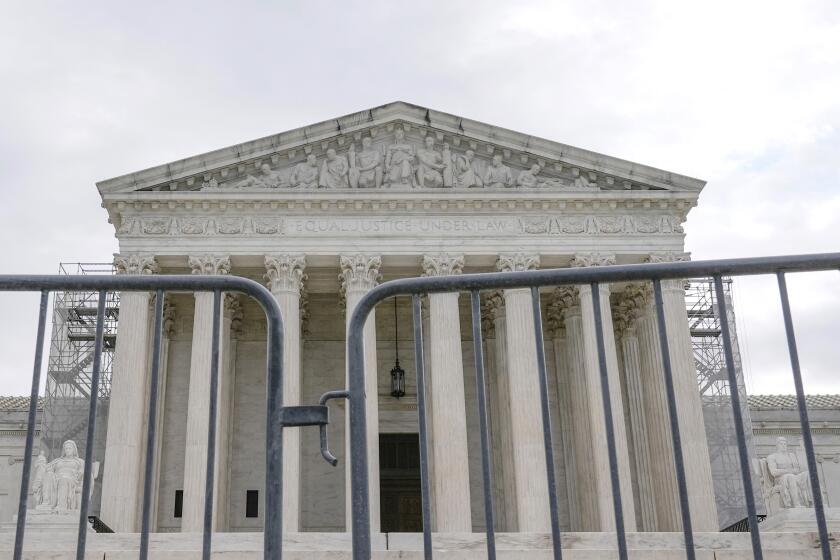Balloting Is Boosted by Young and Conservatives
Young people and social conservatives helped drive a large increase in voting rates Tuesday, producing what analysts said was the nation’s highest turnout since 1968.
When about 5 million still outstanding absentee and provisional ballots are counted, an estimated 119.8 million Americans would have cast ballots in the contentious presidential contest, said Curtis Gans, director of the Washington-based Committee for the Study of the American Electorate.
For the record:
12:00 a.m. Nov. 6, 2004 For The Record
Los Angeles Times Saturday November 06, 2004 Home Edition Main News Part A Page 2 National Desk 3 inches; 95 words Type of Material: Correction
Voter turnout -- An article and an accompanying chart in Thursday’s Section A gave conflicting information about voter turnout in the 1968 presidential election. The article said 60.8% of voting-age Americans voted in the election. That statistic from the U.S. Election Atlas, which obtains its information from the Federal Election Commission, measured turnout among adult U.S. citizens and noncitizens ineligible to vote. The 62% turnout cited in the chart was based on data from the Committee for the Study of the American Electorate that measured voter turnout among eligible U.S. citizens. Both statistics are correct.
Commentators had predicted the emergence of new voters would benefit Sen. John F. Kerry, but Republicans appeared to have been even more successful at getting their new voters to the polls. Those conservatives served as the bedrock of the 3.5-million-vote margin President Bush had over Kerry in the popular vote.
The predicted 59.5% turnout of eligible voters would exceed every election since 1968, when 60.8% of voting-age Americans went to the polls to elect Republican Richard Nixon over Democrat Hubert H. Humphrey and American Independent Party candidate George Wallace. That election occurred at the height of the civil rights movement and the Vietnam War. In the intervening 36 years, the 1992 three-way contest between President George H.W. Bush, Bill Clinton and Ross Perot produced the other notable spike in voting -- with turnout hitting 55.2%.
Commentators said that difficult economic times and Bush’s polarizing presidency helped provide much of the motivation that drove voters to the polls. But another factor also was responsible: the massive get-out-the-vote efforts by Bush’s campaign and by an alliance of organizations supporting Kerry.
“The enduring legacy of the 2004 election is to demonstrate the potency of voter mobilization efforts,” said Donald Green, a Yale University political science professor. “Now that both parties have seen how this can work, we can expect it to be a staple of elections from here on out.”
Turnouts were particularly substantial in the states where Bush and Kerry spent most of their money on advertisements and field operations that assured many voters were called or visited multiple times. The percentage of voting-age Ohio residents casting ballots increased from 56.7% to 65%, compared with the 2000 election.
Gans’ organization reported that Florida and five other Southern states -- Alabama, Georgia, South Carolina, Tennessee and Virginia -- recorded the highest voter participation rates since Reconstruction.
Those states have large populations of Christian conservatives, whose percentage of the electorate increased substantially from 2000. About 14% of voters that year described themselves as members of the “Christian right.” A strictly comparable figure is not available this year, although the broader category of self-described evangelical Christians made up 22% of voters this year, according to one exit poll.
Those voters preferred Bush for taking a firmer stand against abortion and gay marriage. They cast 76% of their ballots for the president.
As early exit poll projections of a strong Kerry showing began to slip away, some commentators blamed young voters for not turning out in the way the Massachusetts senator had hoped.
In fact, voting by those age 29 and younger jumped markedly, from 15% of the electorate in 2000 to 20% this year, according to a Los Angeles Times exit poll. Younger voters picked Kerry by 55% to 43% over Bush, the poll found.
“A lot of people thought the youth vote would be the swing vote in the election,” said Jay Strell, spokesman for Rock the Vote. “They weren’t, but they made it much closer than it would have been otherwise in some states and won some battlegrounds for Kerry.”
More to Read
Get the L.A. Times Politics newsletter
Deeply reported insights into legislation, politics and policy from Sacramento, Washington and beyond. In your inbox three times per week.
You may occasionally receive promotional content from the Los Angeles Times.







